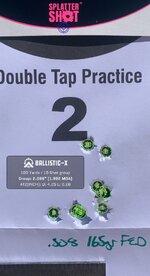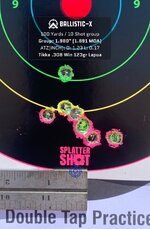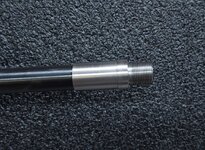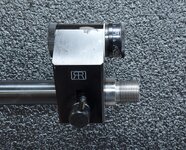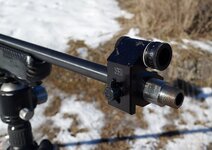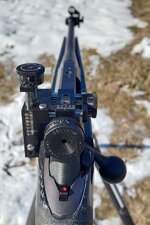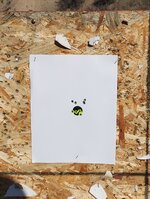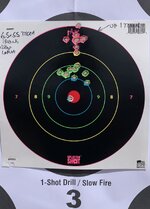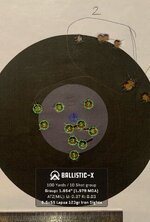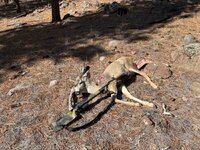cal30_sniper
WKR
It's taken me a while to finish this up, but I'm at a place where I've tested my designs and found them satisfactory for human consumption.
This all started a while back when I put in for one of the restricted weapon rifle tags in Utah and drew with a few years worth of general season preference points. I messed around with a few different guns in the safe, but pretty quickly decided to take Form's advice from another thread and try out a biathlon sight setup. I weighed a bunch of different attachment options, but ultimately decided to design my own setup. What I came up with is:
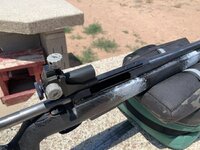
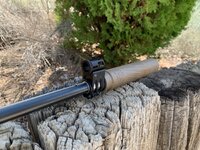
I've been messing with a T3X Drover in .308. I picked up a Rokstok, which ends up being the perfect height for the tall biathalon sight, but found the muzzle shoulder to not be thick enough for reliable muzzle device mounting with the oddball M15x1.0 thread this rifle has. I originally tried a lyman globe sight in the original dovetail, but between the limited inserts, small diameter globe, and low sight height, I decided to go ahead and design a front sight base to tackle a few of the problems at once.
The front sight base design ended up having the following features:
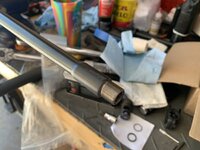
The muzzleloader globe sight is well reviewed elsewhere on this site, but here's an example of some of the inserts available:
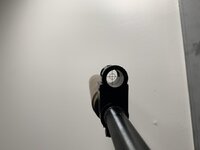
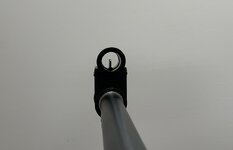
The front sight dovetail uses four of the factory scope mount screws to mount, centers via flathead gunsmithing screws, and is reversible. The reason for reversibility is to allow the rear to overhang the area behind the receiver and support the rear sight when mounted further aft.
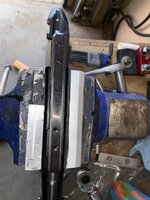
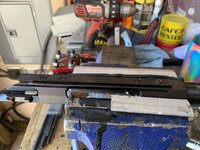
I've tried several different sights at this point mounted on two different rifles. One is the factory Drover in .308, the other is the shortened 6.5x55 barrel from Kampfeld. The rail height, width, etc have all been great with the various biathalon and 11mm airgun sights I've tried:
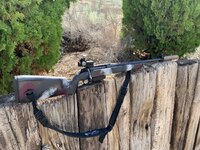
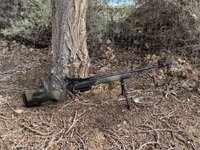
This all started a while back when I put in for one of the restricted weapon rifle tags in Utah and drew with a few years worth of general season preference points. I messed around with a few different guns in the safe, but pretty quickly decided to take Form's advice from another thread and try out a biathlon sight setup. I weighed a bunch of different attachment options, but ultimately decided to design my own setup. What I came up with is:
- 11mm Dovetail that mounts to the factory T3X receiver holes
- Clamp on front sight mount to mount a Williams Precision Muzzleloader Globe front sight


I've been messing with a T3X Drover in .308. I picked up a Rokstok, which ends up being the perfect height for the tall biathalon sight, but found the muzzle shoulder to not be thick enough for reliable muzzle device mounting with the oddball M15x1.0 thread this rifle has. I originally tried a lyman globe sight in the original dovetail, but between the limited inserts, small diameter globe, and low sight height, I decided to go ahead and design a front sight base to tackle a few of the problems at once.
The front sight base design ended up having the following features:
- .750" inner diameter for compatibility with common aftermarket barrel diameters
- A split aluminum adapter sleeve for mounting on a factory Tikka sporter barrel at 20" length
- Uses a M4 flathead screw to align itself with the factory front screw hole on a Ranahan or Drover rifle
- When mounted on the Drover with the aforementioned flathead screw to align, it also provides a shoulder for the muzzle device
- Machined from steel with lightening cuts
- Protective steel ears for the globe sight base include set screws to lock in the sight with more than the provided single 8-40 screw

The muzzleloader globe sight is well reviewed elsewhere on this site, but here's an example of some of the inserts available:


The front sight dovetail uses four of the factory scope mount screws to mount, centers via flathead gunsmithing screws, and is reversible. The reason for reversibility is to allow the rear to overhang the area behind the receiver and support the rear sight when mounted further aft.


I've tried several different sights at this point mounted on two different rifles. One is the factory Drover in .308, the other is the shortened 6.5x55 barrel from Kampfeld. The rail height, width, etc have all been great with the various biathalon and 11mm airgun sights I've tried:



